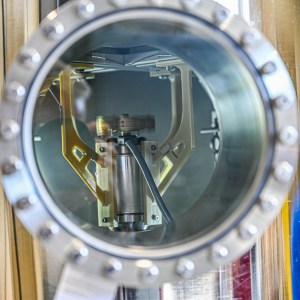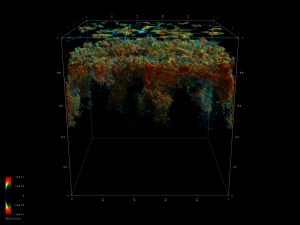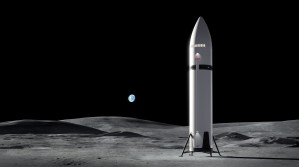
By Savannah Bullard
Artemis I launched from NASA’s Kennedy Space Center in Florida on Nov. 16, 2022, penning a new era of space exploration and inching the agency closer to sending the first woman and first person of color to the lunar surface.
Aboard the Space Launch System (SLS) rocket were 10 small satellites, no bigger than shoeboxes, whose goal was to detach and capably perform operations near and beyond the Moon. One of those satellites was a product of the Cube Quest Challenge, a NASA-led prize competition that asked citizen innovators to design, build, and deliver flight-qualified satellites called CubeSats that could perform its mission independently of the Artemis I mission.
Cube Quest is the agency’s first in-space public prize competition. Opened in 2015, the challenge began with four ground-based tournaments, which awarded almost $500,000 in prizes. Three finalists emerged from the ground competition with a ticket to hitch a ride aboard the SLS as a secondary payload – and win the rest of the competition’s $5 million prize purse, NASA’s largest-ever prize offering to date – in 2022.
Of the three finalists, Team Miles was the sole team to make the trip on Artemis I successfully. Shortly after a successful deployment in space, controllers detected downlink signals and processed them to confirm whether the CubeSat was operational. This remains the latest update for the Team Miles CubeSat.
“We’re still celebrating the many wins that were borne out of Cube Quest,” said Centennial Challenges Program Manager Denise Morris. “The intent of the challenge was to reward citizen inventors who successfully advance the CubeSat technologies needed for operations on the Moon and beyond, and I believe we accomplished this.”
Innovation rarely comes without error, but according to Challenge Manager Naveen Vetcha, who supports Centennial Challenges through Jacobs Space Exploration Group, even after everything goes as expected, there is no guarantee that scientists will reach their desired outcomes.
“Given the magnitude of what we can and do accomplish every day at NASA, it comes with the territory that not every test, proposal, or idea will come out with 100 percent success,” Vetcha said. “We have set ambitious goals, and challenging ourselves to change what’s possible will inevitably end with examples of not meeting our stretch goals. But, with each failure comes more opportunities and lessons to carry forward. In the end, our competitors created technologies that will enable affordable deep space CubeSats, which, to me, is a big win.”
Advancements in Commercial Space Research
Although Team Miles may have made it furthest in the Cube Quest Challenge, having launched its CubeSat as a secondary payload aboard Artemis I, the team continues to participate in the challenge long after launch.
“From Team Miles, Miles Space LLC was created and is still in business,” said Jan McKenna, Team Miles’ project manager and safety lead. “Miles Space is developing and selling the propulsion system designed for our craft to commercial aerospace companies, and we’ve expanded to be able to create hardware for communications along with our CubeSat developments.”
The next steps for Miles Space LLC include seeing through their active patent applications, establishing relationships with potential clients, and continuing to hunt for a connection with their flying CubeSat. Another finalist team, Cislunar Explorers, is currently focused on using their lessons learned to benefit the global small satellite community.
“I utilized the contacts I made through Cube Quest and the other Artemis Secondary Payloads for my thesis research,” said Aaron Zucherman, Cislunar Explorers’ project manager. “This has enabled me to find partnerships and consulting work with other universities and companies where I have shared my experiences learning the best ways to build interplanetary CubeSats.”
Inspiring a Generation of Space Scientists
This challenge featured teams from diverse educational and commercial backgrounds. Several team members credited the challenge as a catalyst in their graduate thesis or Ph.D. research, but one young innovator says Cube Quest completely redirected his entire career trajectory.
Project Selene team lead, Braden Oh, competed with his peers at La Cañada High School in La Cañada, California. Oh’s team eventually caught the attention of Kerri Cahoy at the Massachusetts Institute of Technology, and the designs were similar enough that Cahoy invited the two teams to merge. The exposure gained through this partnership was a powerful inspiration for Oh and his peers.
“I originally intended to apply to college as a computer science major, but my experiences in Cube Quest inspired me to study engineering instead,” Oh said. “I saw similar stories unfold for a number of my teammates; one eventually graduated from MIT and another now works for NASA.”
Cube Quest is managed out of NASA’s Ames Research Center in California’s Silicon Valley. The competition is a part of NASA’s Centennial Challenges, which is housed at the agency’s Marshall Space Flight Center in Huntsville, Alabama. Centennial Challenges is a part of NASA’s Prizes, Challenges, and Crowdsourcing program in the Space Technology Mission Directorate.
Jonathan Deal
NASA’s Marshall Space Flight Center
256-544-0034
jonathan.e.deal@nasa.gov

































